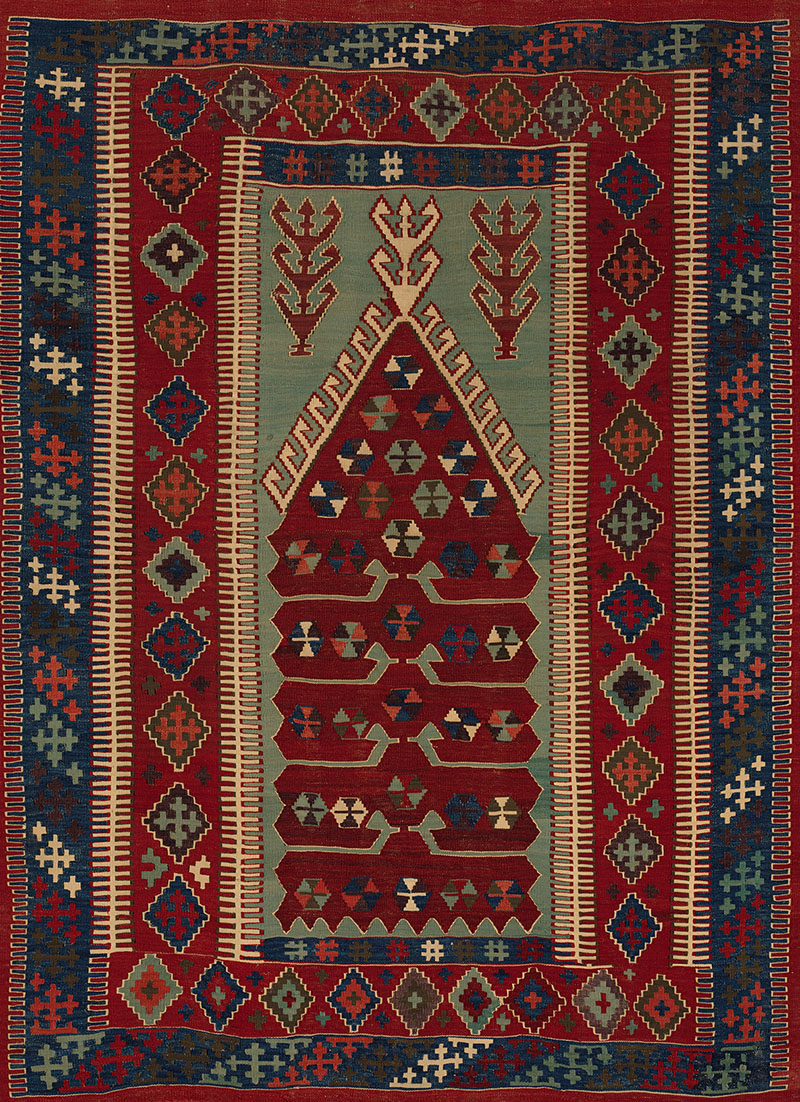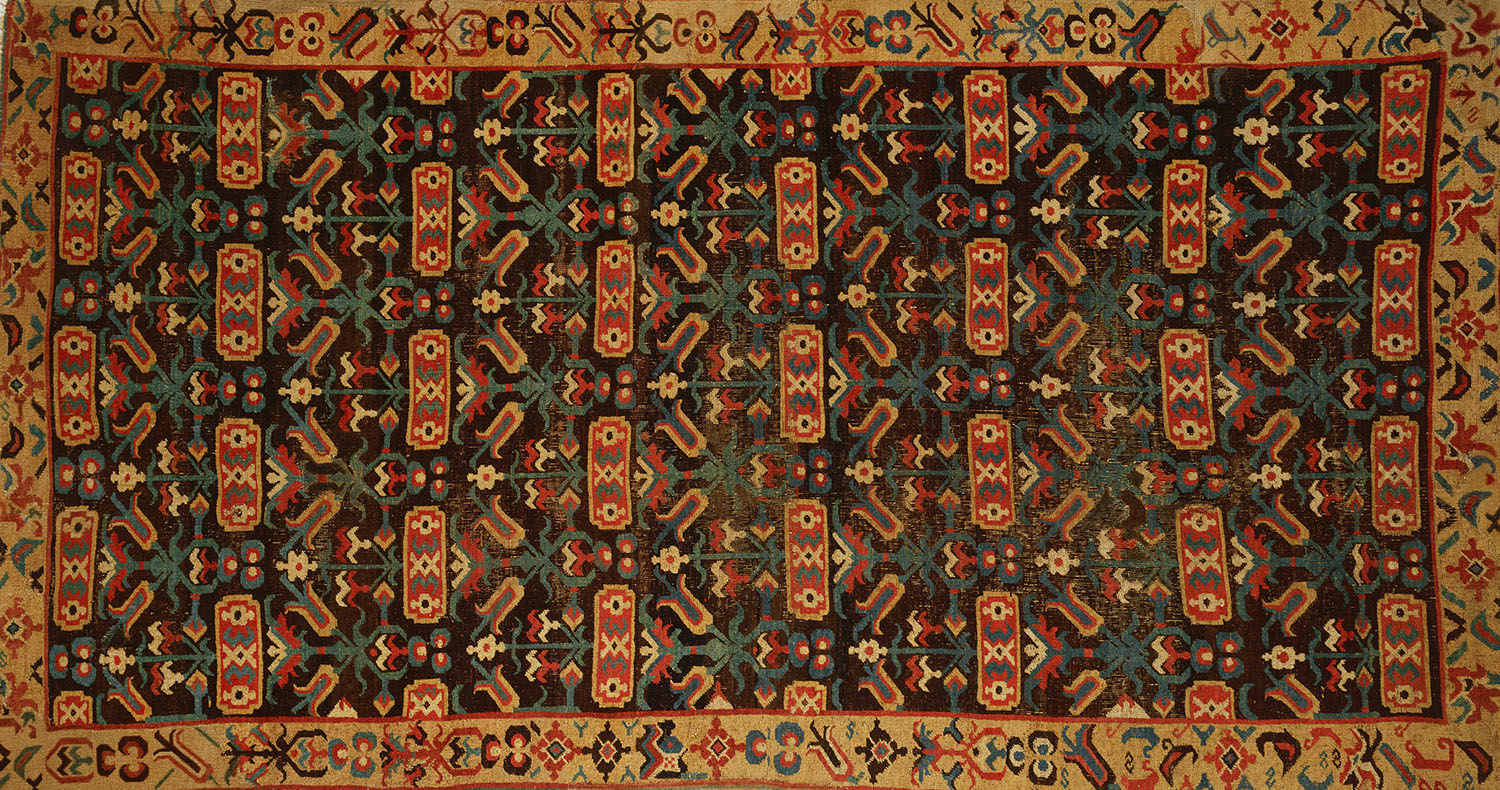ARTICLE
Kilim
In Anatolia, where kilims were first produced, weavers would adapt forms from the natural world into abstract rectilinear motifs and patterns. Most kilims carry motifs pertaining to specific beliefs and myths and also serve as symbols of luck, fertility and power. Traditional kilims also feature motifs drawn from the immediate surroundings of the weaver, primarily domestic items such as kettles and combs, and natural imagery such as flora. In the aftermath of the Soviet occupation of Afghanistan in 1979, weavers in the country began depicting war apparatus on their kilims, in a trend that continued through the United States’ 2001 invasion of Afghanistan to the present.
In South Asia, the modern-day states of India, Pakistan and Afghanistan are known for kilim weaving. It was introduced in India through the imperial carpet-weaving workshops, or farrash-khanas, of the Mughal empire that flourished under the reign of Akbar (r. 1556–1605) in Agra, Delhi and Lahore. The carpets produced in these historic cities featured designs inspired by traditional Persian motifs and patterns, but used brighter colours.
Afghanistan has a rich culture of kilim weaving, though the history of its early emergence is not well documented. A wide range of Afghan kilims are identified based on the region of production and the predominant tribal groups making them. Among the most prominent are Turkmen kilims, named after the peoples of Central Asian descent renowned for their expertise in making carpets, who also inhabit parts of Iran and northern Afghanistan. In contrast with the multicoloured Turkmen rugs from Iran, those from Afghanistan are larger and more subdued in terms of colour and design. They are often characterised by repeating panels or medallions in the central field, which contain ancient totemic symbols or emblems, or gul, often pertaining to specific communities. Rugs of the Ersari tribe of Turkmen from Labijar in northern Afghanistan show motifs such as the arrowhead, which symbolises good luck in hunting; the hourglass, said to bring light and energy; and an S-shaped double-hook motif, which also brings good luck. They are known for their palette of deep reds, blues and browns offset by yellow. Kazakh and Uzbek populations settled in Afghanistan also produce distinctive kilims. The Kazakh rugs, known as lakai, feature a grid of rectangles containing star-motifs, with a three-band border containing repeating triangles and other geometric motifs. The chevron-patterned Uzbek rugs are made of narrow warp-faced strips sewn together, yielding intricate kilims locally known as ghudjeri. Other kilim varieties from the region include the Maimana, which sometimes includes a tulip-inspired design; the Mushwani, after the Persian-speaking tribe of Pashtun ancestry; and the Mukkur Kutchi, named after the town between Kabul and Kandahar.
Afghan communities produced kilims chiefly for personal use and for local markets until the 1960s and 1970s, when these rugs started to receive attention in Western markets following new trade and political connections between Afghanistan and the West. They have since been popular objects of export, not only as craft artefacts for study and display but for use as functional floor coverings.
Today, kilims made with synthetically dyed yarn are used not just as rugs and floor coverings but also for mule saddles, bags, upholstery, cushion covers and wall hangings. Antique kilims are held in the collections of numerous museums and galleries.
Bibliography
“Ersari Rug History & Origin Guide.” Little-Persia. Accessed August 2, 2024. https://www.little-persia.com/pages/ersari-rug-history-origin-guide.
Britannica, T. Editors of Encyclopaedia. “Afghan Carpet.” Encyclopedia Britannica, February 9, 2024. Accessed August 2, 2024. https://www.britannica.com/art/Afghan-carpet.
Britannica, T. Editors of Encyclopaedia. “Ersari Carpet.” Encyclopedia Britannica, April 2, 2018. Accessed August 2, 2024. https://www.britannica.com/art/Ersari-carpet.
Britannica, T. Editors of Encyclopaedia. “Kilim.” Encyclopedia Britannica, April 14, 2018. Accessed June 5, 2024. https://www.britannica.com/topic/kilim.
Chandra, Dhruv. “Rugged Appeal.” India Today, July 17, 2018. https://www.indiatoday.in/magazine/supplement/story/20080728-rugged-appeal-736942-2008-07-17.
Hull, Alastair, and Jose Luczyc-Wyhowska. Kilim: The Complete Guide: History, Pattern, Technique, Identification. United Kingdom: Chronicle Books, 1993. https://archive.org/details/kilimcompletegui0000hull/page/n7/mode/2up.
Kilim. “Weaving Techniques.” Accessed August 24, 2021. https://www.kilim.com/kilim-wiki/weaving-techniques.
Kilim. “What Is a Kilim?” Accessed August 24, 2021. https://www.kilim.com/kilim-wiki/whatskilim.
Krody, Sumru Begler. “The Power of Colour: Anatolian Kilims.” In Textile Society of America Proceedings. Washington, D. C.: George Washington University Museum and the Textile Museum, 2016. https://digitalcommons.unl.edu/cgi/viewcontent.cgi?article=1987&context=tsaconf.
“Gigantic Kilim Carpet Unveiled in Southern Iran.” Tehran Times, February 22, 2021. https://www.tehrantimes.com/news/458446/Gigantic-kilim-carpet-unveiled-in-southern-Iran.
Walker, Daniel. Flowers Underfoot: Indian Carpets of the Mughal Era. London: Thames and Hudson, 1997.








